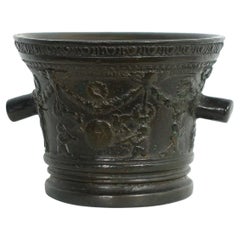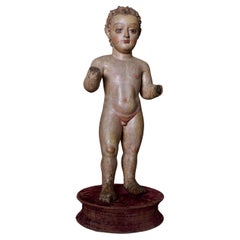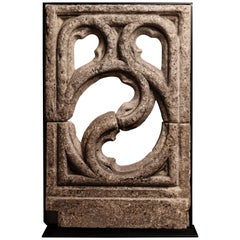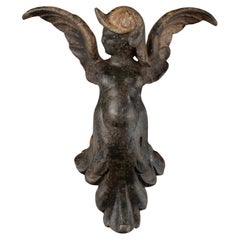Want more images or videos?
Request additional images or videos from the seller
1 of 6
Renaissance Tabernacle Front - Tuscany, first half of the 16th century
$29,696.02List Price
About the Item
- Dimensions:Height: 28.75 in (73 cm)Width: 16.54 in (42 cm)Depth: 3.55 in (9 cm)
- Style:Renaissance (Of the Period)
- Materials and Techniques:
- Place of Origin:
- Period:
- Date of Manufacture:first half of the 16th century
- Condition:Wear consistent with age and use.
- Seller Location:Bruxelles, BE
- Reference Number:1stDibs: LU6666229755292
About the Seller
5.0
Vetted Professional Seller
Every seller passes strict standards for authenticity and reliability
1stDibs seller since 2022
15 sales on 1stDibs
Typical response time: 1 hour
Authenticity Guarantee
In the unlikely event there’s an issue with an item’s authenticity, contact us within 1 year for a full refund. DetailsMoney-Back Guarantee
If your item is not as described, is damaged in transit, or does not arrive, contact us within 7 days for a full refund. Details24-Hour Cancellation
You have a 24-hour grace period in which to reconsider your purchase, with no questions asked.Vetted Professional Sellers
Our world-class sellers must adhere to strict standards for service and quality, maintaining the integrity of our listings.Price-Match Guarantee
If you find that a seller listed the same item for a lower price elsewhere, we’ll match it.Trusted Global Delivery
Our best-in-class carrier network provides specialized shipping options worldwide, including custom delivery.You May Also Like
Venetian 16th Century Wellhead
Located in Zedelgem, BE
16th century wellhead from Venice, rare find, museum quality that needs a bit of restoration, done by us.
The stone it's made out is Italian Pietra Serena.
Category
Antique 17th Century Italian Renaissance Architectural Elements
Materials
Limestone
16th Hand Carved Stone Relief Renaissance Building Façade
Located in Marbella, ES
16th Hand Carved Stone Relief Renaissance Building Façade. Modern Iron Foot
Category
Antique 16th Century Italian Renaissance Architectural Elements
Materials
Stone
Frieze, Polychromed Pine Wood, 16th Century
Located in Madrid, ES
Rectangular frieze in carved pine wood, gilded and polychrome decorated with figurative reliefs. An architectural piece with garland serves as the axis for the symmetrical compositio...
Category
Antique 16th Century European Renaissance Architectural Elements
Materials
Pine
16th Century French Fireplace Mantel
Located in Vosselaar, BE
A monumental 16th century sandstone Renaissance fireplace mantel. Finely sculpted with a moulded beam and colomn supports. Decorated with flower motives, guirlandes and cirkels.
Lov...
Category
Antique 16th Century French Renaissance Fireplaces and Mantels
Materials
Sandstone
16th Century Italian Pair of Antique Corinthian Capitals
Located in West Palm Beach, FL
An antique Italian pair of Corinthian Capitals from the Renaissance period, hand carved in limestone. Minor fading, scratches due to age. Wear consistent with age and use. Circa 1500...
Category
Antique 16th Century Italian Renaissance Architectural Elements
Materials
Limestone
Italian 16th Century Marble Fragment
Located in Round Top, TX
A very stunning 16th century Marble Fragment from the Veneto region of Italy. Beautifully carved with angels or putti and now mounted on its iron...
Category
Antique 16th Century Italian Architectural Elements
Materials
Marble
Antique Fireplace Mantle Empire Style, First Half of the 19th Century, Italy
Located in Cuneo, Italy (CN)
Antique fireplace mantle, hand-carved in Empire style, original from the first half of the 19th century, built for a palace in Italy.
Elegant and composed in shapes, geometric and c...
Category
Antique 19th Century Italian Fireplaces and Mantels
Materials
Marble
$4,751 Sale Price
20% Off
H 40.16 in W 59.85 in D 15.75 in
Pair of Late 16th-Early 17th Century Pinnacle Fragments
Located in Round Top, TX
A very handsome pair of late 16th-early 17th century Pinnacle fragments in polychromed wood. Wonderful architectural elements as they are or perfectly suited to convert into lamps. T...
Category
Antique 17th Century Spanish Architectural Elements
Materials
Wood
15th or 16th Century Marble Gargoyle Fountain Spout from Arezzo, Italy
Located in Dallas, TX
Although when most people hear the word “gargoyle”, they probably envision small, winged creatures with grotesque visages. However, the phrase has a deeper meaning, encompassing any carved head (animal or human) that function as waterspouts.
From the Early Renaissance (late 1400’s/early 1500’s), our gargoyle fountain spout features a human-like face with pointed ears, possibly representing a centaur or a satyr. The roughly rectangular block of marble was hand-carved in Arezzo, in the Tuscany region of Italy. All sides except the front of the cream-colored stone have a sawed finish, resulting in a rough texture. The back has been excavated, adding to the character of the gargoyle. A 1 ½” diameter hole has been cut all the way through, forming an open mouth of the gargoyle. The gaping mouth was often a symbol used to conjure images of devouring giants and used to remind people that they are susceptible to certain forces.
Our 15th/16th century marble...
Category
Antique 16th Century Italian Renaissance Fountains
Materials
Marble
$9,300
H 13 in W 11.25 in D 16.25 in
Outstanding Set of 3 16th Century Spanish Ceiling Panels, Beams
Located in Round Top, TX
An outstanding and exceptional set of 3 16th century ceiling panels - beams from Barcelona. Hand hewn solid wood panels beautifully painted. Fabulous architectural elements to incorp...
Category
Antique 16th Century Spanish Architectural Elements
Materials
Wood
$8,950 / set
H 10 in W 92.5 in D 1.5 in
More From This Seller
View AllBronze Mortar, Tuscany, Second Half of 16th Century
Located in Bruxelles, BE
Bronze mortar with garlands, flowers and putti - Tuscany , second half of 17th century.
Measures: height 10
diameter : 13 cm
Artisans and healers used mortars for grinding food...
Category
Antique 16th Century Italian Renaissance Scientific Instruments
Materials
Bronze
Child Jesus - Umbria, first half of the 16th century
Located in Bruxelles, BE
Child Jesus
Polychrome and gilded wood
Umbria, first half of the 16th century
H 40 cm
Entirely naked, the Child is standing, leaning on his left leg, his right leg forward; he keep...
Category
Antique 16th Century Italian Renaissance Religious Items
Materials
Wood
Carved Limestone Balustrade, North of France, First Half of the 15th Century
Located in Bruxelles, BE
Carved Limestone balustrade.
In a modern metal frame.
North of France, Ile de France or Normandy.
End of the 14th century - first half of the 15th century.
Measures: 90 x 62 x 8...
Category
Antique 15th Century and Earlier French Medieval Architectural Elements
Materials
Limestone
$14,254 Sale Price
20% Off
Renaissance Harpy - Italy, 16th century
Located in Bruxelles, BE
Renaissance Harpy
bronze
Italy, 16th century
15 x 12 x 5,5 cm
This expressive bronze figure represents a harpy, a mythological creature with the body of a bird and the head and tor...
Category
Antique 16th Century Italian Renaissance Figurative Sculptures
Materials
Bronze
Renaissance relief - Italy, probably Rome, 16th century
Located in Bruxelles, BE
Renaissance relief depicting two female figures dressed in a chiton
Italy, probably Rome, 16th century
Marble, wooden frame (provenance label on the back)
28 x 20 x 5 cm
This beau...
Category
Antique 16th Century Italian Renaissance Wall-mounted Sculptures
Materials
Marble
renaissance wooden candelabrum and painted cross - Umbria, 16th century
Located in Bruxelles, BE
Base of a carved wooden candelabrum, polychrome and gilded; cross painted on both sides.
Umbria or Tuscany, 16th century
136 x 43,5 x 30 cm
(The cross and the base of the candelabrum were later assembled)
The base of the candelabrum is intricately carved and adorned with polychrome and gilded finishes. The shafts take on the shape of balusters reminiscent of ancient columns, feature ornate foliage decorations, garlands and winged cherub faces. The feet are crafted in the likeness of lion paws. The base is further embellished with depictions of four saint martyrs, among them Saint Barbara and Saint Catherine of Alexandria. The plasticity of the figures, outlined with strong contour lines, the clear and vibrant colors, are stylistic elements linked to the Umbrian tradition of the sixteenth century.The precisely defined and elegant drawing, along with the clear color palette applied with refined chiaroscuro modulations, became the signature of a style that would leave a lasting mark on the era to come. This is exemplified by a preference for vibrant, multicolored images, accentuated in this case by the use of red and pink in the saint's attire.
A notable addition, introduced later, is a polylobed cross painted on both sides. On one side, the Crucifixion is vividly portrayed:The treatment of the corpus itself is in line with High Medieval practice, emphasizing pathos by showing Jesus dead, his arms sagging from the weight of the body. The upper section displaying a pelican pecks at her breast to feed her young with her own blood; a symbol of the sacrifice of Christ on the cross whose body and blood similarly nourishes the celebrant during Mass.
The lower part depicts Golgotha. On the reverse side, the Resurrection is artistically presented in a Renaissance iconography, reminiscent of the renowned composition painted by Piero della Francesca, now housed in the Civic Museum of Sansepolcro. In terms of composition, with the frontal depiction of Christ holding the banner, this motif became particularly widespread in central Italy, spanning from Tuscany to Umbria throughout the 16th century..
The double-sided construction suggests that it may also have been carried in liturgical processions. In Umbria from the 14th century, the use of portable crosses painted on both sides had become a widespread practice, aimed at satisfying the monastic clientele that had significantly increased following the establishment of new religious communities.
The earliest surviving Tuscan painted crucifix represent Christ as Christus Triumphans, or the “Triumphant Christ” with his head up and eyes open. This form was supplanted in the 13th century with the Christus Patiens, or “Suffering Christ” type who is shown often with his head fallen on his shoulder and his eyes closed, as In our cross. The iconography of the suffering Christ appears to have developed out of a new interest in Christ’s human nature, the development of the feast of Corpus Christi and with increased importance given to the Eucharist. The process of humanizing the figure of Christ reaches its peak with the abandonment of all the previous expressive conventions in favor of more realistic details we can observe in this Crucifix, such as the swollen belly, the arms stretched to the limit of muscle tearing, the body falling heavily forward, the abundant blood on
the wounds, and the cross firmly embedded in the rock of Calvary.
It's worth noting that Renaissance candelabra...
Category
Antique 16th Century Italian Renaissance Figurative Sculptures
Materials
Wood, Giltwood



